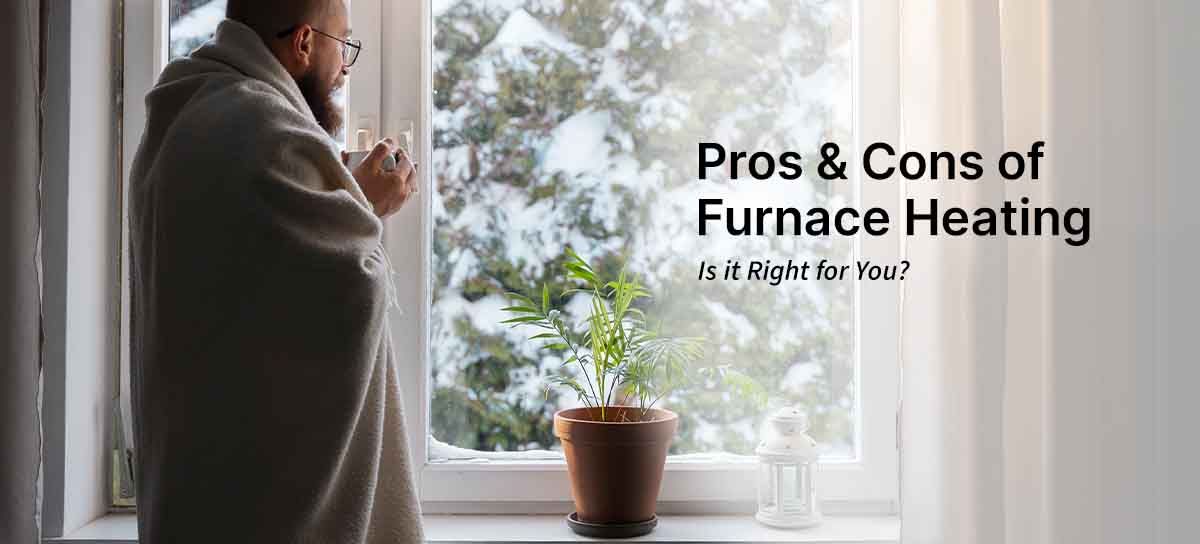
When the winter weather really hits and the temperatures drop well-below freezing, just about everyone relies on a furnace to help heat their home and maintain a comfortable indoor temperature.
This is exactly why furnace problems, whether it be an aging furnace or damaged components, can make you uncomfortable quite quickly. You may deal with increased shivering, reduced sleep quality, and a drop in productivity. You may also experience issues like higher utility bills and more emergency repairs if your furnace is not working properly.
Winter furnace maintenance is key to preventing all of this.
In this blog, we’re uncovering the benefits of regular furnace maintenance in the winter, as well as how you can prepare your furnace before the cold weather truly hits, and the best tips for maintaining you furnace in the winter.
Do not hesitate to reach out for any of your HVAC needs, including furnace inspection and repairs. Our experienced team of HVAC technicians is one phone call or email away, so don’t be afraid to reach out.
You can experience many benefits by conducting winter furnace maintenance, from increased comfort in your home to a longer furnace lifespan.
Let’s take a look at the most common benefits:
Most furnaces come with a warranty that dictates the kind of repair and replacement policy a homeowner can expect for their unit. However, just like with any other type of appliance or system in the home, the furnace warranty comes with requirements that must be met. One of the most common of these requirements is annual furnace maintenance.
Winter furnace maintenance in particular is a key component of ensuring your furnace continues to function as intended – intentionally compromising its function can void the warranty, increasing your costs for repair and replacement.
Reports indicate that for the average home, the furnace accounts for up to half of the annual energy usage. This is why ensuring the furnace is performing as efficiently as possible is so important.
Dirty air filters, debris in the furnace, and broken parts cause the furnace to use more energy to heat your home. However, regular furnace maintenance helps keep the furnace clean and all parts working as they should. In turn, this can result in the furnace using up to 30% less energy.
Furnaces are meant to heat homes throughout the winter so the indoor temperature remains comfortable for those living in the home as well as those who visit. However, furnaces can only maintain a comfortable indoor temperature if the whole system is functioning properly.
For instance, a debris blockage in one part of the system may reduce the amount of hot air that can get to a particular room in the home, creating a cold spot. Dirty air filters may mean the air cannot get as warm as it should throughout the home. Broken parts can cause even more issues with temperatures throughout the home.
Regular furnace maintenance in the winter ensures there are no blockages or other issues that can cause cold spots to develop in the home, ensuring everyone can remain comfortable no matter where they are.
Many factors can result in furnaces using more energy to heat homes than necessary, including:
As furnaces are responsible for up to 50% of the average home’s annual energy usage, they are often the biggest expense on energy bills. However, a maintained furnace uses less energy, which can help introduce cost savings to energy bills, especially in the winter.
Most furnaces can last for around 15 to 20 years and heat homes well throughout that period. However, a lack of furnace maintenance in the winter can mean the furnace will last less than 10 years. Engaging in regular maintenance appointments can help ensure a furnace operates efficiently, ensuring each part is in good working condition, and identify problems when the furnace is still salvageable.
Regular furnace maintenance, in the end, delays furnace replacements and other costly repairs. In many cases, it also means your furnace can last as long as 20 or even 30 years.
Certain issues with your furnace, such as a compromised heat exchanger or ignition assembly, can introduce a safety hazard in your home. This includes an increased risk of a fire or even carbon monoxide problems.
Regular winter maintenance helps identify furnace problems early and fix them, allowing you to heat your home without worrying. Each furnace maintenance appointment includes a thorough inspection of all furnace parts, including those where issues may cause safety concerns.
If your furnace breaks down on a particularly cold day in the winter, things can get uncomfortable very quickly. In addition to this, it can be quite expensive to get your furnace fixed on short notice – besides the fact that the necessary repair itself may also carry a hefty price tag.
However, regular furnace maintenance can help reduce the need for emergency maintenance calls, since the furnace is less likely to suddenly break down if all parts are inspected and cleaned on a regular basis.
Now that you know about the most common benefits of regular furnace maintenance in the winter, it is time to start learning about what you can do to get your furnace ready for the colder months.
Here are the top 4 tips for preparing your furnace for the winter:
Your HVAC system likely includes both a heating and cooling component. However, you do not need the air conditioner during the winter, especially in Canada. Thus, you can start getting your furnace ready by covering up your air conditioner. This actually helps ensure your air conditioner is protected from the winter weather, including extreme snowfall, freezing rain, and falling ice.
A board can help protect the unit, as can specially made AC unit covers. Just do not use a tarp that can trap moisture close to your unit – this may cause rust to form.

Turning up the thermostat a few degrees is a crucial way to find out whether your furnace is functioning the way it should. Once you adjust your thermostat settings, listen. You should hear your furnace turn on in a couple of minutes – if this does not happen, or if your furnace is making an unusual noise, you need to investigate the issue.
Some of the places to check include the:
Of course, if your furnace is not working, you should call an experienced HVAC technician to conduct a thorough furnace inspection.
Carbon monoxide detectors when your furnace is running are crucial as the gas is both odorless as well as colourless, which means the detectors are the only way to know if its present in your home. If you do not already have then in your home, make sure you get them installed for the winter when your furnace will be running. If you have them, run a quick performance test. They are life-saving in an emergency!
Many people cover the heating vents in their home throughout the summer. If this is the case for you, preparing your furnace for the winter needs to include uncovering these vents, as this is how your furnace will be able to safely and efficiently heat your home so you stay comfortable.
Besides the simple actions to prepare your furnace for the cold winter months, there are also key tips for winter furnace maintenance you should keep in mind so you can maximize the benefits of your furnace for as long as possible.
Here are the top 4 tips for regular maintenance of your furnace you need to know:
Before winter really hits and you will be using your furnace, you should make sure to change your HVAC air filter(s). As winter goes on, you should be cleaning and changing the air filter(s) every 30 to 45 days. This is frequent because most people spend a lot of time in their homes throughout the winter, which means their furnaces will be running more frequently.
Changing the air filter(s) helps maintain indoor air quality and extends the useful life of your furnace.
Your furnace needs to turn on in order to keep your home warm throughout the winter. Thus, part of maintenance needs to include testing the igniter switch. If you have an older model in your home, you may need to relight the pilot flame when you are doing this. Newer models have electric switches – but you still need to test that yours works before the winter gets really cold.
If you find your furnace doesn’t respond when you are testing the igniter switch, you should call a furnace repair technician.
If your forced-air furnace vents through a chimney, you absolutely need to clear out your chimney as part of your regular furnace maintenance. Clearing your chimney means it will be free of obstructions, such as nests for small animals, as well as soot buildup. A clear chimney reduces the risk of a fire breaking out in your home in the winter.
To work at its ideal level, you need to inspect and clean your furnace regularly – so make sure it is part of your winter furnace maintenance routine.
Parts you will need to inspect and clean include the:
When it comes to regular furnace maintenance in the winter, you may want to consider calling an HVAC professional for a furnace inspection appointment. They can inspect your furnace system thoroughly and identify any parts that may require repairs. Furnace technicians can also clean your furnace thoroughly and perform the other furnace maintenance tasks mentioned thus far.
Do not hesitate to reach out for any of your HVAC needs, including furnace inspection and repairs. Our experienced team of HVAC technicians is one phone call or email away, so don’t be afraid to reach out.

Choosing the right method to heat your home is not a decision to take lightly. This becomes especially important during the frigid months of our Canadian winters.
In this blog post, we'll share some of the pros and cons of furnace heating to help determine if it's the right choice for your comfort and budget. From its efficient and rapid heat distribution to potential cost savings and compatibility with central air, we'll explore the advantages that make furnace heating a compelling option. But we won't shy away from the drawbacks, discussing installation costs, environmental concerns, and health considerations.
We understand how this can seem daunting and overwhelming at best. We are here to support you through this process. Our highly skilled team is one phone call or email away, so don’t be afraid to reach out for any of your HVAC needs.
Furnace heating is a method of heating your home that uses a centralized heating unit to distribute warm air throughout the living space. Furnace systems operate from a single point within the home, typically the basement or utility room, and use ductwork to transport heated air to various rooms.
A furnace heating system burns a fuel source or uses electricity to generate heat. In the case of gas furnaces, natural gas or propane is ignited in a combustion chamber, while electric furnaces use heating elements. Once heat is produced, a blower fan forces air over the heated elements or through a heat exchanger, warming it in the process. The heated air is then circulated through the ductwork and released into rooms through vents or registers.
Different types of furnaces have different characteristics and advantages. Common types include:
Furnace heating excels in extremely cold climates, as it can generate and deliver a consistent supply of warm air to combat freezing temperatures effectively.
Furnaces are designed to provide rapid heat distribution. When you turn on your furnace, it can quickly raise the indoor temperature, ensuring that your home feels warm and comfortable within a relatively short time.
In some cases, furnace heating can be cost-effective, especially if you have access to a relatively inexpensive fuel source, such as natural gas. High-efficiency furnace models can further enhance cost savings by reducing energy consumption.
Furnace heating systems often work in conjunction with central air conditioning systems.
Furnaces are known for their durability and can have a long lifespan with regular maintenance. Proper care, including annual inspections and filter changes, can extend the life of your furnace and ensure its efficient operation for many years.
Furnace heating systems typically have a significant upfront cost. This includes not only the purchase of the furnace unit itself but also installation costs, which may involve ductwork installation or modifications, electrical work, and venting, making it a substantial investment compared to other heating options.
The choice of energy source for your furnace can impact operating costs. For instance, gas prices and electricity rates can fluctuate, affecting the cost-effectiveness of running a gas or electric furnace.
Furnaces, especially those powered by fossil fuels like natural gas or oil, contribute to greenhouse gas emissions when they burn these fuels for heat.
Furnace heating systems require regular maintenance to operate efficiently and safely. This includes changing filters, cleaning ducts, inspecting burners, and ensuring proper ventilation. Neglecting maintenance can lead to reduced efficiency and potential safety hazards.
Furnaces can affect indoor air quality if not properly maintained. Dust, allergens, and pollutants can accumulate in the ducts and air filters, reducing air quality.
When asking yourself this question, consider the following:
Annual professional furnace inspections and servicing are crucial for ensuring the safety and efficiency of your heating system, as trained technicians can detect hidden issues, perform essential maintenance, and avoid potential hazards. This provides you with peace of mind and a reliable heating system.
We understand how this can seem daunting and overwhelming at best. We are here to support you through this process. Our highly skilled team is one phone call or email away, so don’t be afraid to reach out for any of your HVAC needs.
